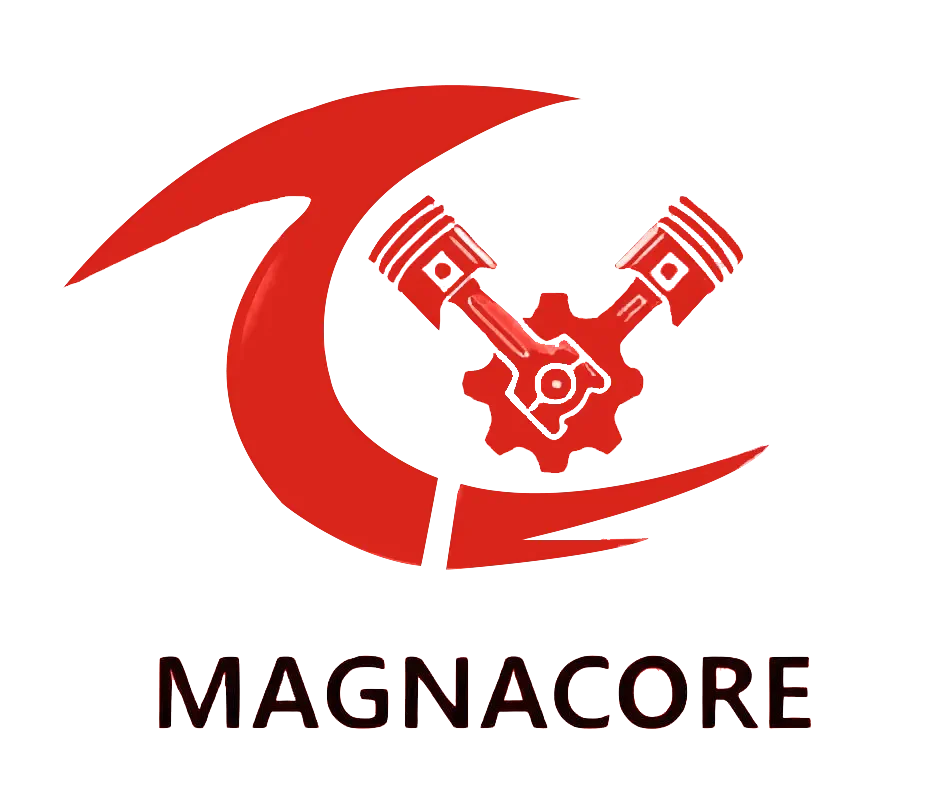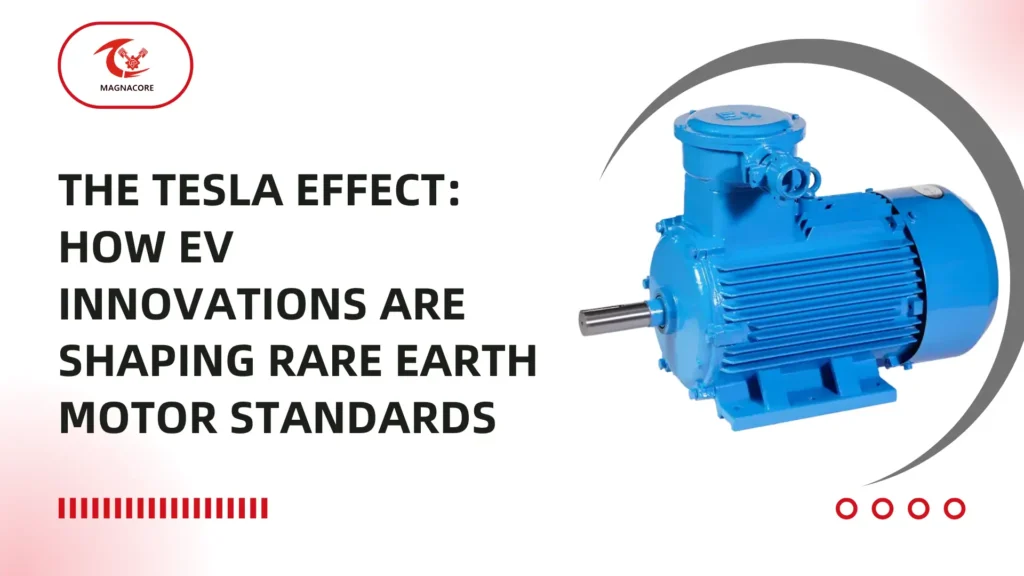The electric vehicle (EV) revolution, led by pioneers like Tesla, is transforming more than just transportation—it’s redefining performance benchmarks for rare earth motors across industries.
As automakers push the boundaries of efficiency and power density, these advancements are trickling down to industrial applications, creating new standards for motor performance.
This article explores how EV-driven innovations are influencing motor design and what it means for your business.
How Did Tesla Change the Game for Motor Design?
Relentless Focus on Power Density
Tesla has fundamentally transformed motor design with its relentless focus on power density.
The company’s electric motors achieve unprecedented kilowatts per kilogram (kW/kg) ratios, setting a new standard in the industry.
This emphasis on lightweight, powerful motors compels competitors to rethink their traditional designs and engineering approaches.
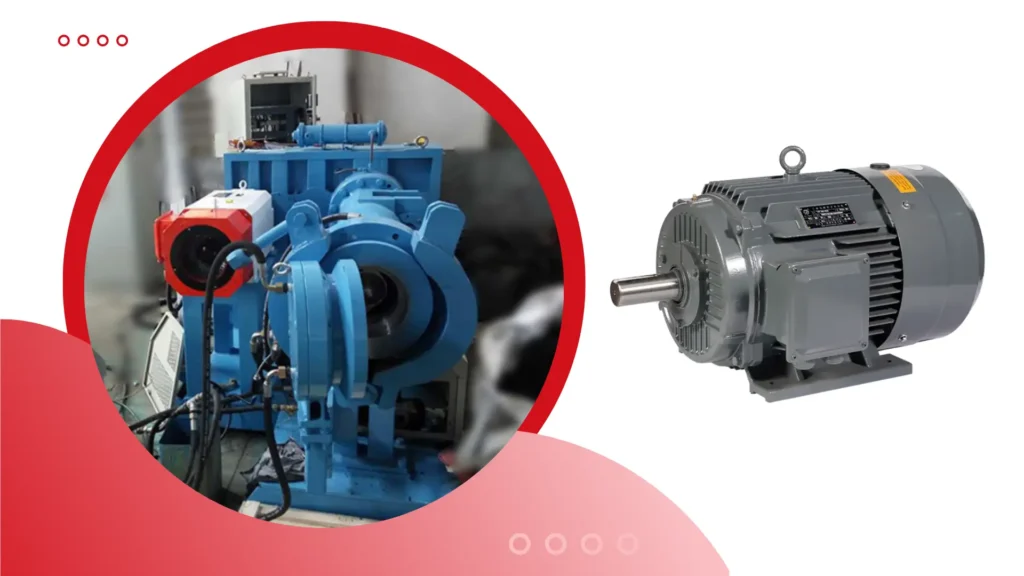
Redefining Efficiency Expectations
Tesla’s innovations have redefined expectations for motor efficiency, particularly in electric vehicles (EVs).
Today, EV-grade motors routinely exceed 95% efficiency, a benchmark that challenges conventional motors in industrial applications.
This high level of efficiency not only optimizes energy consumption but also extends the operational range of electric vehicles, making them more appealing to consumers.
The push for higher efficiency in motors is becoming a crucial factor in design and selection processes, influencing the entire landscape of motor technology.
System-Level Integration
Another significant advancement introduced by Tesla is the integration of motor, inverter, and cooling systems into a cohesive unit.
This holistic design approach demonstrates how combining these components can lead to substantial performance gains.
This integrated methodology serves as a model for future motor designs, encouraging manufacturers to consider system-level interactions rather than focusing on individual components in isolation.
What New Magnet Technologies Emerged from EVs?
High-Temperature Magnet Formulations
The development of high-temperature magnet formulations has emerged as a significant advancement from the EV industry.
New neodymium alloys have been engineered to withstand temperatures exceeding 200°C while maintaining their magnetic strength.
This capability is crucial for applications in electric vehicles, where high operating temperatures can be a challenge.
The introduction of these high-performance magnets not only enhances the reliability of EV motors but also opens up opportunities for their use in other high-temperature environments, such as industrial machinery and aerospace applications.
Reduced Heavy Rare Earth Content
Innovations in magnet technology have also led to a reduction in the heavy rare earth content used in magnet formulations.
Techniques such as grain boundary diffusion have been developed to cut the usage of critical elements like dysprosium and terbium by 50-80%.
This reduction not only lowers production costs but also addresses supply chain concerns associated with rare earth materials.
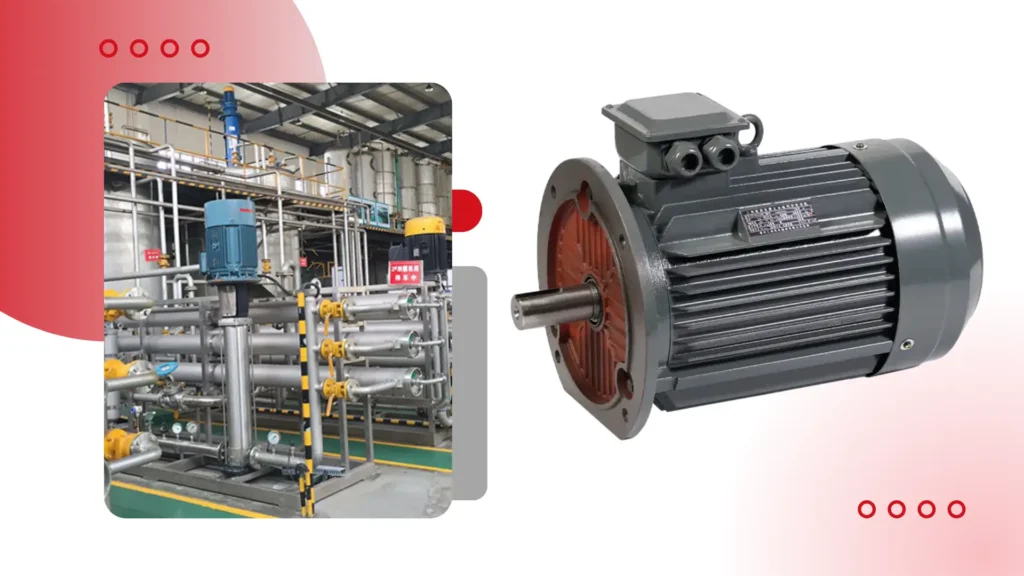
Improved Corrosion Resistance
New magnet coatings developed for harsh automotive environments have significantly improved corrosion resistance in magnets.
These advancements are particularly beneficial for industrial motors that operate in challenging conditions, where exposure to moisture and contaminants can lead to degradation.
Enhanced corrosion resistance ensures that magnets maintain their performance and longevity, reducing the need for frequent replacements and minimizing maintenance costs.
This innovation not only boosts the durability of motors but also supports the overall efficiency and reliability of various applications across different industries.
And More:
- Advanced Features of High-Performance Permanent Magnet Motors from China
- Top 10 Permanent Magnet Motor Manufacturers in France
How Are Cooling Systems Evolving?
Direct Oil Cooling Adoption
Direct oil cooling, once exclusive to high-performance EVs, is now making its way into industrial high-power motors.
This cooling technique involves circulating oil directly through the motor to absorb and dissipate heat more effectively than traditional air cooling methods.
The adoption of direct oil cooling is driven by the need for higher efficiency and reliability in demanding applications.
Integrated Cooling Channels
Innovations inspired by EV designs have led to the embedding of cooling channels directly into motor housings and rotors.
This integration allows for more efficient heat dissipation by ensuring that cooling fluids are in direct contact with heat-generating components.
The result is a more compact design that maximizes thermal management while minimizing overall system size.
This approach not only enhances performance but also facilitates easier installation and maintenance, making it an attractive option for modern motor designs in both automotive and industrial applications.
Smart Thermal Management
The evolution of cooling systems is also marked by the introduction of smart thermal management strategies.
These adaptive cooling systems utilize real-time data and advanced algorithms to optimize cooling based on environmental conditions and operational demands.
This level of sophistication allows for improved efficiency and reliability, making smart thermal management essential for high-performance motors in both EVs and industrial applications.

What Manufacturing Advances Came from EV Scale?
Automated Winding Techniques
The scale of EV production has driven significant advancements in manufacturing processes, particularly in automated winding techniques.
The adoption of robotic hairpin winding, which offers improved precision and efficiency, has become commonplace in EV motor production.
This technique is now being integrated into premium industrial motors, allowing manufacturers to achieve higher quality and consistency in winding.
The increased automation not only boosts production rates but also reduces labor costs, making it a valuable advancement for any motor manufacturer aiming to compete in a rapidly evolving market.
Precision Magnet Assembly
Advancements in automotive-grade magnet positioning systems have led to improved precision in magnet assembly for motors.
These systems enable tighter tolerances, which are crucial for optimizing motor performance and efficiency.
The ability to position magnets accurately results in better magnetic alignment, enhancing the overall effectiveness of the motor.
Moreover, these precision processes can be implemented at lower costs, making high-quality magnet assembly more accessible to a wider range of manufacturers, including those in the industrial sector.
Modular Design Approaches
The rise of electric vehicles has also popularized modular design approaches in motor manufacturing.
EV-inspired scalable motor architectures allow for easier customization and flexibility in design, enabling manufacturers to adapt motors to specific applications without extensive re-engineering.
This modularity simplifies the production process and reduces lead times, allowing companies to respond more quickly to market demands.
Also Read:
- Overview of Permanent Magnet Synchronous Motors in China
- How to Mitigate Risks When Sourcing Rare Earth PMS Motors Globally
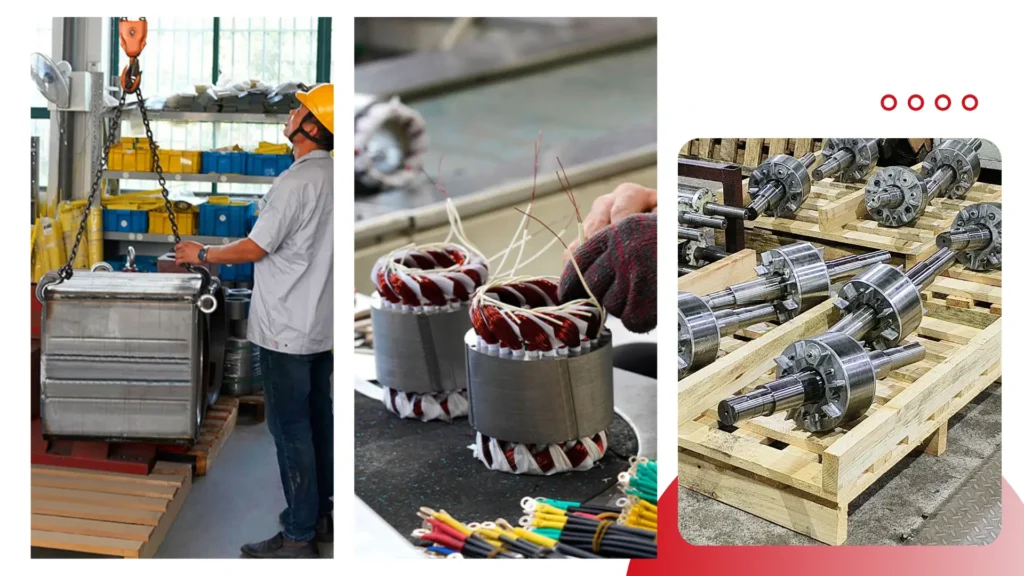
How Are Control Systems Improving?
Silicon Carbide Inverter Tech
The introduction of Silicon Carbide (SiC) inverter technology represents a significant advancement in motor control systems.
Developed primarily for electric vehicles (EVs), these wide-bandgap semiconductors enable faster switching speeds and higher efficiency in power conversion.
SiC inverters can handle higher voltages and temperatures, which improves overall system performance and reduces losses during operation.
This technological leap not only enhances the responsiveness of motor control but also contributes to longer battery life and improved energy efficiency in various applications, from EVs to industrial motors.
Predictive Algorithms
Control systems are also benefiting from the integration of predictive algorithms powered by machine learning models.
These advanced algorithms, originally developed for EV motor control, can adapt to variations in industrial load conditions in real-time.
The ability to predict and adjust to load changes dynamically allows for smoother operation and increased efficiency, making predictive algorithms a valuable asset in modern motor control systems.
Ultra-Precise Position Sensing
Improvements in position sensing technologies, such as resolvers and encoders, have originated from the EV sector and are now being applied across various industries.
These technologies offer ultra-precise position sensing with sub-degree accuracy, which is crucial for applications requiring high levels of precision and control.
Enhanced position feedback allows for more accurate motor control, leading to improved performance in applications such as robotics, CNC machines, and automation systems.
This level of precision not only enhances operational efficiency but also supports the development of advanced automation solutions.
What Efficiency Standards Are Changing?
New IE5+ Classifications
The evolution of efficiency standards has led to the introduction of new IE5+ classifications, which recognize ultra-premium efficiency levels for electric motors.
These classifications have been influenced by advancements in electric vehicle technology and are designed to promote the adoption of highly efficient motor designs.
The IE5+ standard sets a higher benchmark for energy efficiency, encouraging manufacturers to innovate and improve their products.

Partial Load Performance
Efficiency standards are also shifting towards a greater emphasis on partial load performance.
Inspired by the efficiency curves seen in electric vehicles, these new standards prioritize real-world operating conditions rather than just peak ratings.
Since motors often operate at partial loads in practical applications, evaluating efficiency across a range of operating conditions ensures a more accurate assessment of performance.
This approach encourages manufacturers to design motors that maintain high efficiency even under varying load conditions, leading to better overall energy savings.
System-Wide Metrics
The assessment of motor efficiency is evolving from focusing solely on standalone measurements to evaluating complete drive system metrics.
This system-wide approach considers all components involved in the motor’s operation, including the motor itself, the inverter, and any associated controls.
This holistic perspective not only improves the accuracy of efficiency assessments but also fosters the development of integrated solutions that optimize overall performance and energy savings across the system.
And More:
- A Comprehensive Guide to Permanent Magnet Synchronous Motor Wholesale in China
- Top Factors to Consider When Buying Rare Earth PMS Motors for Your Business
How Is Supply Chain Innovation Reducing Costs?
Localized Rare Earth Sourcing
Supply chain innovations in the EV sector are leading to localized rare earth sourcing strategies that help mitigate geopolitical risks for all users.
As the demand for rare earth materials, essential for high-performance motors, continues to grow, manufacturers are shifting towards sourcing these materials closer to home.
This localization reduces dependency on foreign suppliers and minimizes the impact of geopolitical tensions on supply chains.
Recycling Breakthroughs
Recent breakthroughs in recycling processes for rare earth magnets are providing significant benefits to industrial users.
New techniques for recovering magnets from end-of-life EVs allow for the reclamation of valuable materials that can be reused in new motor production.
This recycling not only reduces the demand for newly mined rare earth elements but also lowers material costs and promotes sustainability.
Standardized Platforms
The development of standardized platforms across various power ranges is another innovation that helps lower development costs in the motor industry.
These shared component architectures enable manufacturers to streamline their design processes and reduce the complexity associated with developing unique components for each motor type.
This approach not only enhances efficiency in manufacturing but also allows for easier upgrades and modifications, ultimately benefiting customers with more versatile and cost-effective solutions.

What Does This Mean for Motor Buyers Today?
Higher Performance Expectations
Today’s industrial users are raising their performance expectations, reasonably demanding EV-grade specifications in premium motors.
The advancements driven by the EV industry have set a new benchmark for efficiency, power density, and durability.
This shift in expectations challenges manufacturers to innovate continuously, ensuring that their products meet the high standards established by the rapidly evolving electric vehicle market.
Faster Technology Transfer
The pace at which innovations are transferring from the EV sector to industrial markets has accelerated significantly.
Historically, it took 5-7 years for new technologies to migrate into industrial applications. However, advancements are now reaching these markets within 2-3 years.
This faster technology transfer benefits industrial buyers by providing access to the latest innovations, allowing them to improve efficiency and performance in their operations.
This rapid adoption of technology enhances competitiveness and enables businesses to stay ahead in an increasingly demanding landscape.
Improved Total Cost of Ownership
The advancements driven by the electric vehicle revolution are also contributing to an improved Total Cost of Ownership (TCO) for high-performance motors.
As supply chain innovations and recycling breakthroughs reduce material costs, buyers can expect more affordable options without sacrificing quality or efficiency.
These improvements make high-performance motors more accessible, enabling organizations to invest in better technology that delivers long-term savings.
Understanding these benefits allows motor buyers to make informed decisions that enhance their operational capabilities and financial outcomes.
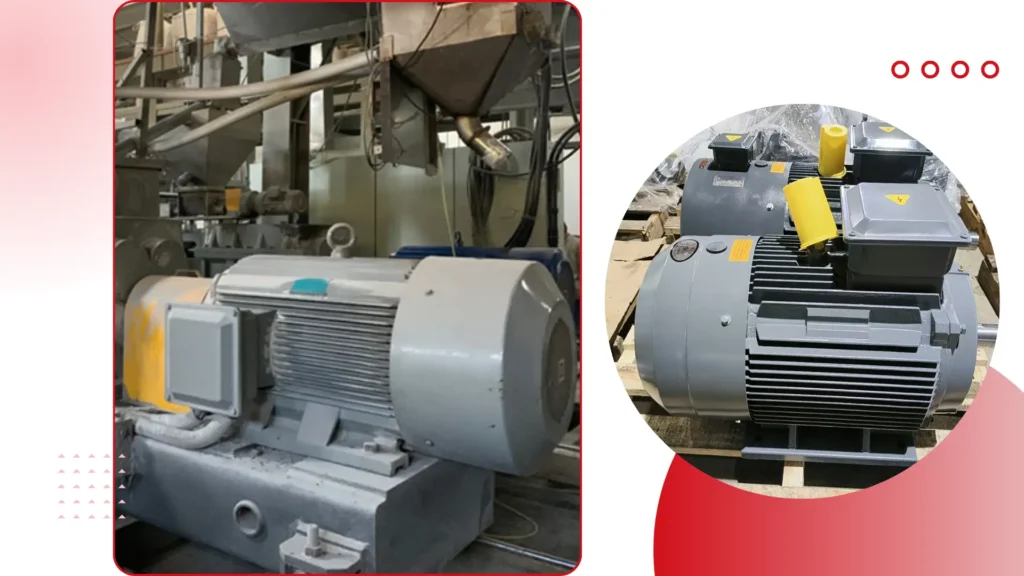
Conclusion
The “Tesla Effect” has significantly accelerated rare earth motor innovation across various industries, resulting in tangible benefits in performance, efficiency, and cost.
By recognizing these EV-originated advancements, industrial buyers can make better-informed decisions that future-proof their operations.
The standards for motors of tomorrow are being shaped today by the ongoing evolution in the electric vehicle sector, ensuring that industries are equipped with the latest technologies to meet their needs.
